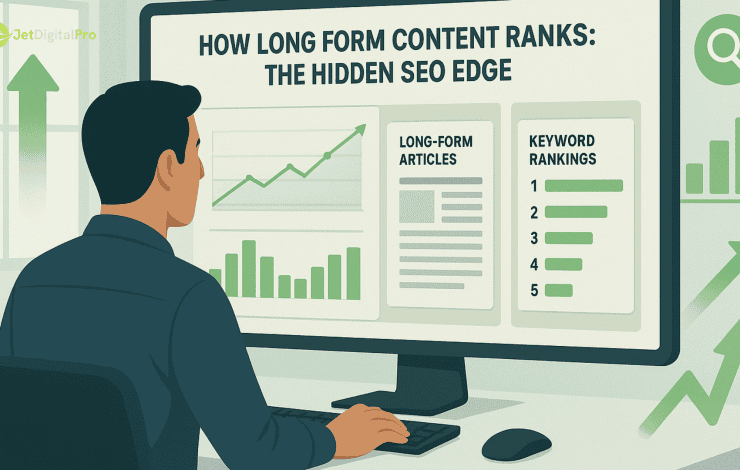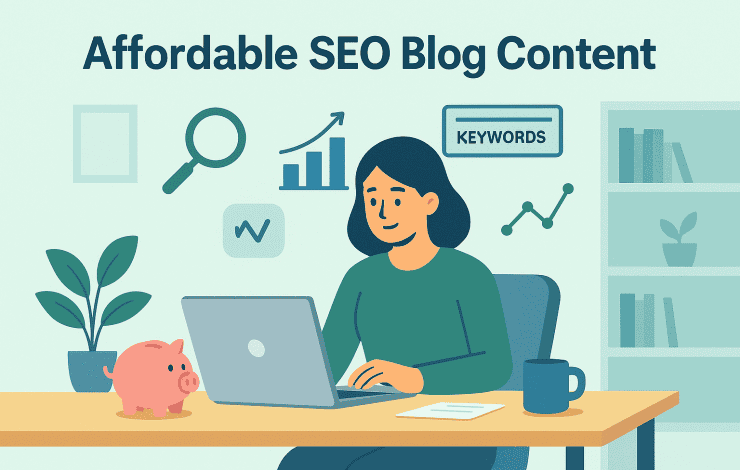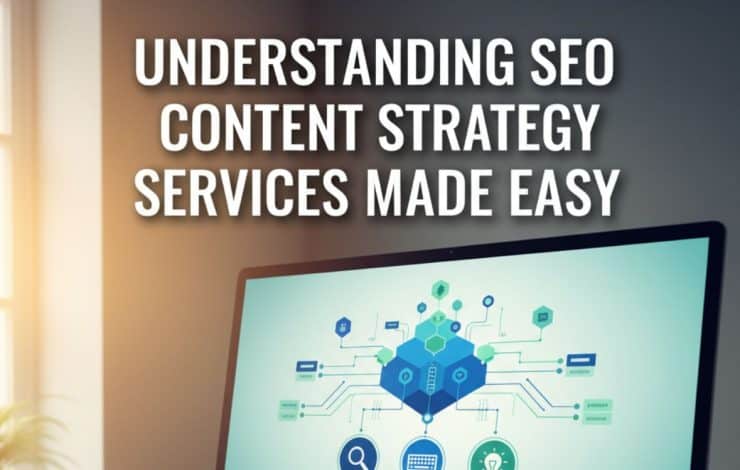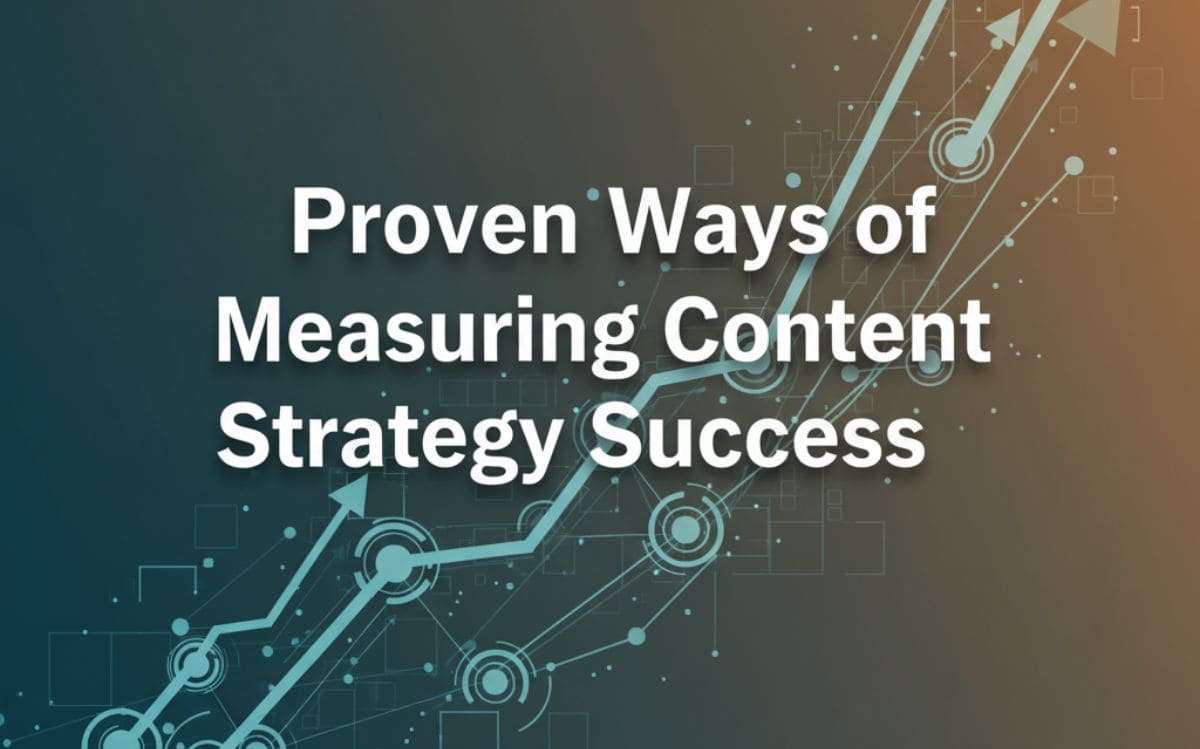
Getting content strategy right comes down to one thing: knowing if it’s actually working. After spending three years helping clients at Jet Digital Pro figure this out, it’s clear that measuring content strategy success isn’t just about racking up likes or watching page views climb. Those vanity metrics might look nice in reports, but they don’t pay the bills.
What really matters is how content drives actual business results. Whether that’s building brand recognition, pulling in organic search traffic, or turning readers into customers, it all comes down to measuring the right things. In practice, content marketing is delivering results: 87% of marketers say content helped create brand awareness in the last 12 months, and 74% report it generated demand or leads.(1)
Key Takeaway
- Align your content goals closely with your overall business objectives like brand awareness and lead generation
- Use a combination of traffic, engagement, and conversion metrics to get a full view of content performance
- Regularly review data using tools like Google Analytics and adjust your content strategy based on insights
Setting Content Strategy Objectives
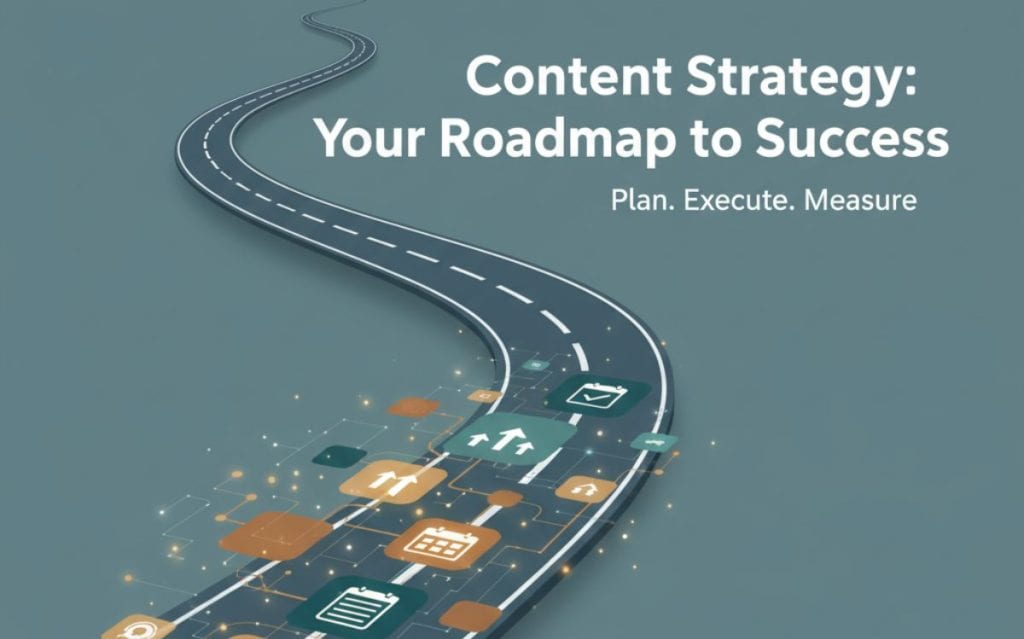
Good content planning’s like mapping a route before a long drive. Without it, you’ll probably end up lost somewhere in Nebraska wondering what went wrong. Strong planning also means working within a clear seo content strategy that connects business objectives with measurable actions.
Defining Business Goals for Content Success
Let’s face it. Every piece of content needs a real reason to exist. Sometimes that’s getting the company name out there (brand awareness stuff), and other times it’s about snagging those sweet, sweet leads. The trick is matching what the content does with what the business actually needs.
- Brand visibility goals. Getting eyes on the content, tracking mentions
- Lead targets, collecting emails, form fills, actual human inquiries
- Sales objectives, dollars and cents from content-driven conversions
Selecting Key Performance Indicators (KPIs)
Nobody likes flying blind. That’s where KPIs come in. They’re the gauges that tell us if this content machine’s actually working. Different goals need different meters:
For conversion tracking:
- Percentage of visitors who buy/sign up
- Cost per conversion (usually $5-50 depending on industry)
- Time from first visit to purchase
For engagement measurement:
- Average time on page. Benchmarks vary by content type, but cross-industry medians fall under a minute (one large dataset shows a ~52-second average); for substantive blog content, 2-3 minutes is a useful target.(2)
- Social shares and comments
- Bounce rates (under 60% is pretty good)
The whole point’s keeping an eye on numbers that actually matter, not just what’s easy to track. Because at the end of the day, if the content isn’t doing what it’s supposed to, what’s the point?
Analyzing Content Performance Metrics
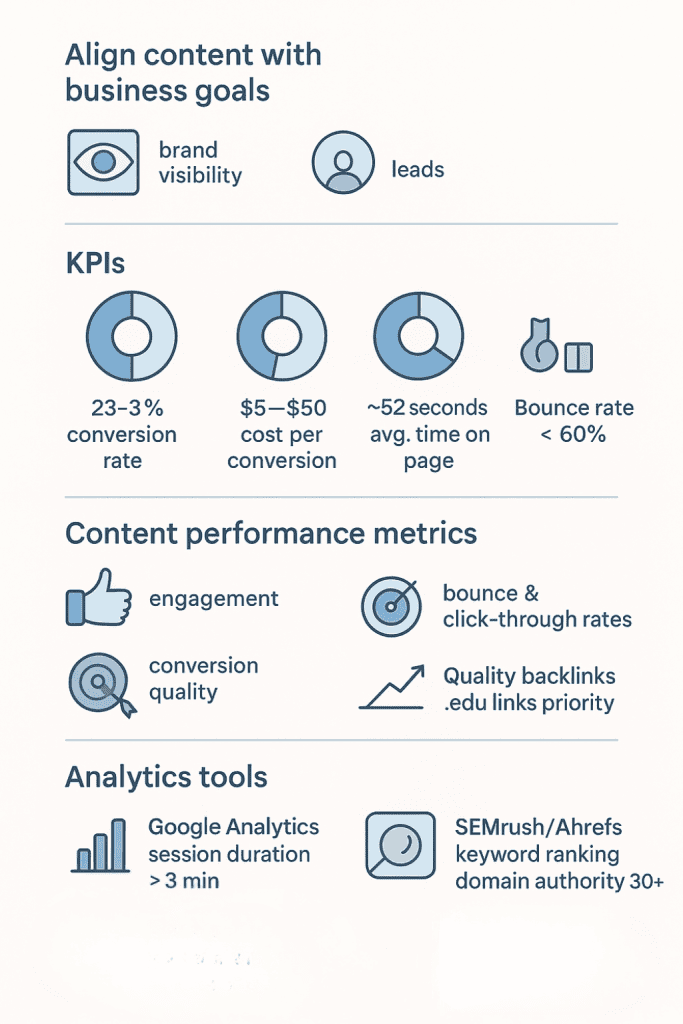
Numbers don’t lie, but they sure like to play hard to get sometimes. Breaking down these metrics is like being a detective. There’s always more to the story than what first catches the eye.
Measuring Conversion Effectiveness
Getting people to actually do something after reading content. That’s the real test. Sure, a 2-3% conversion rate might look okay on paper, but what if those leads are about as qualified as a ham sandwich? The key’s watching both how many people convert and whether they’re worth the effort.
Assessing Traffic and User Engagement
Raw traffic numbers can make anyone feel good (or terrible), but they’re just the start. When someone spends 4+ minutes reading a blog post, that means something. And if they’re scrolling all the way down? Even better. But those 2 second bounces? Yeah, something’s definitely off there.
Evaluating Interaction and Retention Metrics
Nobody likes seeing an 80% bounce rate staring back at them. It’s like throwing a party and watching everyone leave after the first song. Click-through rates tell an interesting story too. Anything above 2% on CTAs is decent, below that and maybe the content’s not quite hitting the mark.
Monitoring SEO and Organic Visibility
The slow climb up Google’s rankings isn’t exactly thrilling television, but it matters. When organic traffic grows month over month (even just 5-10%), that’s content doing its job. Backlinks from actual legitimate sites (not those sketchy directories from 2005) show the content’s actually worth something to others in the field.
Remember, sometimes the most telling metric is the one that looks completely normal until you dig a little deeper. That’s where the real insights hide.
Utilizing Analytics Tools for Content Insights
Getting a handle on content performance feels like trying to drink from a fire hose sometimes. But with the right tools, it’s more like having a really smart assistant who’s done all the homework for you.
Implementing Google Analytics for User Behavior Analysis
Google Analytics might be free, but it’s still the heavy hitter in the room. Once it’s set up right (and that’s key, garbage in, garbage out), it shows exactly how people move through content. The behavior flow thing’s particularly interesting. It’s like watching little digital breadcrumb trails of where readers go.
Some key stuff to watch:
- Session duration (anything over 3 minutes is solid)
- Pages per session (2+ means they’re actually interested)
- Exit pages (where people give up and leave)
- Goal completions (the money stuff)
The real magic happens when you dig into those individual page reports. You might find that blog post you thought was boring is actually keeping people around for 6+ minutes. Or that fancy infographic? Maybe it’s sending people running for the hills after 10 seconds.
Leveraging SEO Tools like SEMrush and Ahrefs
Sure, these tools cost some serious cash (usually $99-500 monthly), but they’re worth their weight in gold for content folks who actually want to know what’s working. Many teams now balance automation with human AI editors to refine insights and scale production without losing quality.
hey show which keywords are bringing in traffic, who’s linking to the content, and what the competition’s up to. What to keep an eye on:
- Keyword position tracking (especially movement in the top 20 spots)
- Domain authority scores (30+ is decent for most businesses)
- Competitor content gaps
- Backlink quality (one good .edu link beats 100 sketchy ones)
Applying Marketing Platforms such as HubSpot
This is where things get interesting. Connecting those content dots to actual sales. HubSpot and similar platforms help track the whole journey, from someone reading a blog post to becoming a customer six months later.
The platform helps track:
- Content attribution (which pieces actually lead to sales)
- Lead scoring based on content interaction
- Email engagement with content
- Campaign performance across channels
The best part’s the automated reporting. Instead of spending hours pulling data every month, these tools spit out ready-to-go reports. Though let’s be honest. They still need a human brain to figure out what it all means.
Here’s the thing about all these tools. They’re great, but they’re just tools. It’s like having a fancy kitchen doesn’t automatically make anyone a chef. The real value comes from knowing which metrics actually matter for your specific goals, and having the patience to watch trends over time instead of freaking out over every little daily change.
And sometimes the most valuable insights come from combining data from different tools. Maybe Google Analytics shows high engagement, but HubSpot reveals those engaged readers never turn into customers. That’s the kind of stuff that helps make actual improvements, not just chase vanity metrics.
Continuous Content Strategy Optimization
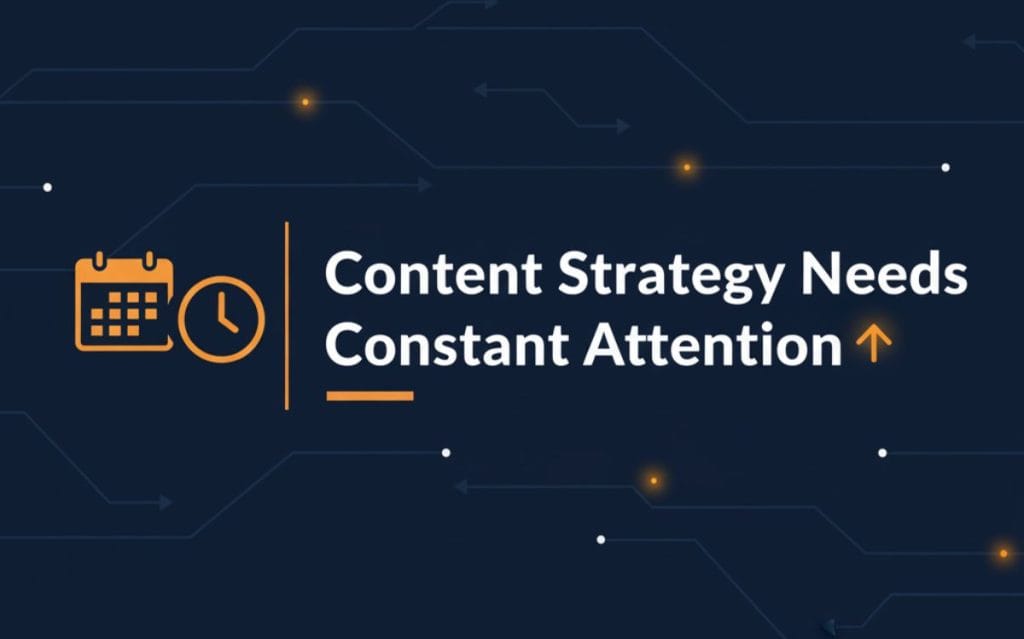
Like tending a garden, content strategy needs constant attention. Some days you’re pulling weeds, other days you’re planting new seeds. And sometimes you’re just standing there wondering why that one section won’t grow no matter what you do.
Conducting Holistic Content Measurement
Content’s got a whole life cycle, kind of like a butterfly but with more spreadsheets. From the moment someone dreams up a blog post to the point where it’s actually making money, there’s a ton of moving parts to watch:
Creation phase metrics:
- Production time (usually 2-8 hours per piece)
- Resource costs
- Editorial calendar adherence
Distribution performance:
- Social media reach
- Email open rates (20%+ is decent)
- Syndication success
Conversion tracking:
- Lead generation numbers
- Sales attribution
- Customer feedback scores
Establishing Regular Performance Reviews
Nobody likes meetings about meetings, but regular check-ins on content performance actually matter. Setting up some solid benchmarks helps everyone know if things are working or if it’s time to hit the panic button:
Monthly targets to watch:
- Engagement rates (comparing similar content types)
- Conversion percentages (industry standards vary widely)
- Bounce rates (under 65% for most content)
- Time on page (at least 2-3 minutes for substantial pieces)
The trick’s not getting too hung up on day-to-day fluctuations. Content’s more like a marathon than a sprint Sometimes you need to look at 3 month trends to see what’s really going on.
Enhancing Content Quality and User Experience
Are You a Digital Agency?
White Label SEO Content Services for Agencies
Scalable, customizable, and results-driven content solutions for your clients.
Numbers are great and all, but they don’t tell the whole story. Sometimes a piece with amazing stats isn’t actually helping anyone, while something with modest numbers is quietly converting like crazy. This is where human editors make a difference, ensuring that content quality stays aligned with audience expectations and long-term seo performance.
Quality checks to consider:
- Reader surveys (aim for 100+ responses)
- Comment sentiment analysis
- Direct feedback from sales teams
- Social media conversations
The real gold often comes from actually talking to users. Maybe they love the content but hate the PDF download process. Or they’re finding exactly what they need but the mobile experience is driving them nuts. That’s the kind of stuff analytics might miss.
A solid optimization process usually looks something like this:
- Monthly metric reviews
- Quarterly deep dives into trends
- Semi annual content audits
- Annual strategy adjustments
But here’s the thing. It’s got to be flexible. Maybe a competitor launches something game changing, or Google does one of those updates that sends everyone scrambling. The best content strategies bend before they break.
The whole point’s keeping content fresh and relevant without chasing every new trend that pops up on Twitter. It’s about finding that sweet spot between “if it ain’t broke, don’t fix it” and “this definitely needs updating before it becomes completely useless.”
Remember, sometimes the best optimization is knowing when to leave well enough alone. Not every piece needs to be perfect, and not every metric needs to be record breaking. Sometimes “good enough” is actually… good enough.
FAQ
What are the key metrics for measuring content strategy success across social media, email marketing, and paid social?
The key metrics for measuring content strategy success include open rates, engagement rate, completion rate, conversion rates, website traffic, referral traffic, and share of voice. Tracking these metrics across social media, email marketing, and paid social helps you understand how well your content resonates with your target audience. Using analytics tools in real time allows you to monitor audience size and distribution channels, ensuring that your marketing efforts align with business goals and deliver a measurable return on investment.
How can web analytics and analytics tools help you measure the number of returning visitors and improve your content?
Web analytics and analytics tools help you measure the number of returning visitors, the percentage of people completing desired actions, and the average time users spend on different content formats. This data allows you to understand which content types and distribution channels perform best for your audience. By analyzing these performance metrics regularly, you can identify areas for improvement, enhance marketing ROI, and optimize content marketing strategies for social channels, search engines, and social commerce platforms.
Why is understanding audience size and engagement metrics important for content measurement and marketing strategy?
Understanding audience size and engagement metrics is crucial for content measurement because it shows how effectively your content captures attention. Measuring social shares, engagement rate, and the number of times content is viewed helps you determine whether your strategy-based approach reaches the right target audience. These marketing metrics provide insights into content marketing ROI, return on investment, and overall business objectives, while also guiding adjustments in content formats and distribution channels to improve effectiveness.
How do marketing goals and business objectives tie into measuring content strategy success with content marketing ROI?
Need a Strategic SEO Content Partner?
Let’s craft SEO content that ranks, converts, and grows your brand.
Talk to UsMarketing goals and business objectives provide the context for measuring content strategy success. By tracking metrics such as conversion rates, lead generation, ad spend, cost per click, and return on investment, you can evaluate content marketing ROI accurately. Aligning content types, social channels, and email marketing campaigns with these goals helps you understand how well your content drives desired actions, supports customer retention, and meets performance metrics. This approach highlights areas for improvement and ensures that digital marketing efforts contribute meaningfully to business objectives.
What role do search engines, content formats, and distribution channels play in effective content measurement and digital marketing?
Search engines, content formats, and distribution channels are essential for effective content measurement. Monitoring website traffic, referral traffic, and share of voice across social channels and search engines allows you to determine whether content resonates with your target audience. Using tools like Google and other analytics tools enables you to measure the number of people engaging with content, returning visitors, and completion rates. This information informs marketing strategy, enhances content marketing ROI, and helps you improve your content to better achieve business goals and marketing objectives.
Conclusion
Look, content success isn’t rocket science. We figured that out pretty quick at Jet Digital Pro. Numbers tell stories, but only if you know how to read them. And yeah, we use AI tools, cause who doesn’t these days? But there’s always a human brain making the final call.
Some agencies just chase whatever’s trending. Not us. We dig into the metrics that actually move the needle for your business. The stuff that makes your boss smile. Real results. Been doing this long enough to know what works. Our white label services? They’re built for agencies who want to grow but don’t want the headache. No BS, just content that performs.
Want to stop guessing and start knowing what works? Drop us a line. Let’s make those numbers work for you.
Related articles
- https://jetdigitalpro.com/understanding-seo-content-strategy-service/
- https://jetdigitalpro.com/scaling-content-with-human-ai-editors/
- https://jetdigitalpro.com/why-human-editors-are-critical-for-seo/
References
- https://contentmarketinginstitute.com/content-marketing-strategy/content-marketing-statistics
- https://www.metrichq.org/marketing/average-time-on-page/
P.S – Whenever you’re ready,
we’re here to help elevate your SEO content.
Partner with us for strategic, scalable content that drives real organic growth.
Contact Us Now

